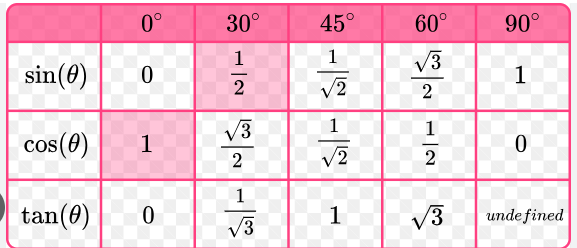Pure - YEAR1
1/36
There's no tags or description
Looks like no tags are added yet.
Name | Mastery | Learn | Test | Matching | Spaced |
|---|
No study sessions yet.
37 Terms
Index laws:
-
-
-
-
am x an = am+n
am / an = am-n
(am)n = amn
(ab)n = an bn
x2+y2=…
(x + y)(x - y)
Index laws with rational power:
-
-
-
-
a0 = 1
a-m = 1/am
an/m = m√an
a1/m = m√a
rules to manipulate surds:
-
-
√ab = √a x √b
√a/b = √a/√b
rules to rationalise denominators:
-
-
1/√a x √a/√a
1/a + √b x a - √b/a - √b
what is a domain
the set of possible inputs for a function
what is a range
the set of possible outputs of a function
the discriminant rules:
-
-
-
b2 - 4ac > 0, f(x) has two distinct real roots
b2 - 4ac = 0, f(x) has one repeated root
b2 - 4ac < 0, f(x) has no real roots
translate y = f(x) + a
(0)
(a)
translate y = f(x + a)
(-a)
(0)
translate y = af(x)
stretched by a scale factor of a in the vertical direction
translate y = f(ax)
stretched by a scale factor of 1/a in the horizontal direction
translate y = -f(x)
reflection of the graph in the x-axis
translate y = f(-x)
reflection of the graph in the y-axis
equation of a line with the gradient m that passes through the point with coordinates (x1, y1):
y - y1 = m(x - x1)
distance between two coordinates:
(x1, y1), (x2, y2)
√(x2 - x1)2 + (y2 - y1)2
equation of a circle with centre (0, 0)
x2 + y2 = r2
equation of a circle with centre (a, b)
(x - a)2 + (y - b)2 = r2
Coefficients in the expansion of (a + b)n
found in the (n + 1)th row of Pascal’s triangle
nCr
n!/r! x (n-r)!
Binomial expansion

cosine rule
a2 = b2 + c2 - 2bc cos A
sine rule to find the length of a missing side
a/sin A = b/sin B = c/sin C
sine rule to find a missing angle
sin A/a = sin B/b = sin C/c
area of triangles when you know two sides and the angle
½ ab sin C
exact values of trigonometric ratios

f’(x) = …

differentiating rules:
-
f(x) = xn, f’(x) = nxn-1
The function f(x) is increasing on the interval [a, b] if…
…f’(x) >= 0 for all values of x such that a < x < b
The function f(x) is decreasing on the interval [a, b] if…
…f’(x) <= 0 for all values of x such that a < x < b
If a function f(x) has a stationary point when x = a then when is the point a local minimum
if f’’(a) > 0
If a function f(x) has a stationary point when x = a then when is the point a local maximum
if f’’(a) < 0
If a function f(x) has a stationary point when x = a then when is the point a local maximum, local minimum or a point of reflection
if f’’(a) = 0
Integrating rule
xn = xn + 1/n+1 + c
laws of logarithms
-
-
-
logax + logay = logaxy (multiplication law)
logax - logay = logax/y (division law)
loga(xk) = k logax (power law)
logarithms in special cases
-
-
-
loga1 = 0
logaa = 1
loga1/x = logax-1= -logax
when ex=5
ln(ex) = ln5
x = ln5